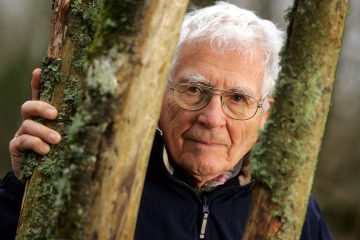Table of Contents
- Exploring the Gaia Hypothesis and Its Relevance Today
- James Lovelocks Vision of Earth as a Living Organism
- The Interconnectedness of Life: Implications for Sustainability
- Evaluating the Scientific Critique of the Gaia Theory
- Future Pathways: Embracing Lovelocks Insights for Environmental Action
- Q&A
- Insights and Conclusions

Exploring the Gaia Hypothesis and Its Relevance Today
The Gaia Hypothesis, proposed by James Lovelock, presents a radical view of Earth as a self-regulating entity, where living organisms and their inorganic surroundings form a complex, interacting system. This concept suggests that life not only interacts with the environment but also plays a significant role in maintaining the conditions necessary for life itself. By viewing the Earth as a single organism, the hypothesis challenges traditional scientific paradigms, encouraging a holistic understanding of ecological systems and their interdependencies.
Today, the relevance of the Gaia Hypothesis resonates particularly in discussions surrounding climate change and environmental sustainability. As humanity grapples with ecological crises, this framework encourages a shift from anthropocentric views to a more integrated approach. Some key implications of the Gaia Hypothesis for contemporary issues include:
- Interconnectedness: Recognizing that actions in one part of the globe can have ripple effects on ecosystems elsewhere.
- Resilience: Understanding how ecosystems adapt to changes and how this resilience can be fortified through sustainable practices.
- Ethical Stewardship: Advocating for a responsibility to protect and nurture the planet, emphasizing collective action over individual gain.
In an era where the consequences of human activity on natural systems are becoming starkly apparent, the Gaia Hypothesis serves as both a warning and a call to action. It urges us to rethink our relationship with the planet, emphasizing the potential for a symbiotic existence that benefits both humanity and the biosphere. By acknowledging the Earth as a living system, we are prompted to consider sustainable practices that not only protect our environment but also foster a thriving planetary community.

James Lovelocks Vision of Earth as a Living Organism
James Lovelock’s revolutionary concept of Gaia positions our planet as a singular, interconnected organism, a living system that actively regulates its environment to sustain life. This theory emerges from an intricate understanding of the Earth’s biophysical processes, emphasizing that life and the environment are intricately linked. According to Lovelock, it’s not just the presence of life that shapes our planet, but rather life itself participates in the Earth’s maintenance. This perspective acknowledges the complex interplay between the atmosphere, oceans, soil, and all living organisms, suggesting a form of planetary self-regulation.
At the core of Lovelock’s vision is the belief that Earth is far more than a mere collection of resources and organisms. He posits that this living system possesses its own feedback mechanisms, where various elements work cohesively to maintain conditions ideal for life. For instance, when temperatures rise, the biosphere can respond by altering the composition of the atmosphere or changing ocean currents. This dynamic balancing act highlighted by Lovelock encourages a deeper respect for nature, urging us to reconsider our integral role within this vast web of life. Some key characteristics of this living organism include:
- Self-regulation: The ability to adapt and stabilize the climate.
- Interconnectedness: Every element, from microscopic bacteria to massive trees, plays a role in sustaining life.
- Feedback loops: Natural responses to changes in the environment that assist in maintaining balance.
This holistic view of Earth invites further exploration into how human action disrupts these natural processes. Lovelock emphasizes that understanding Gaia is essential for addressing critical issues like climate change and environmental degradation. By recognizing the planet as a living organism, we must embrace a stewardship role, fostering a sustainable relationship with this complex system. Below is a simplified comparison of how traditional views contrast with Gaia’s perspective:
| Traditional View | Gaia’s Perspective |
|---|---|
| Earth as a resource | Earth as a living system |
| Humanity separate from nature | Humanity part of nature |
| Static processes | Dynamic feedback mechanisms |

The Interconnectedness of Life: Implications for Sustainability
Understanding the intricate relationships that bind various forms of life and their environments reveals a profound truth: every element in our ecosystem is interdependent. This dynamic web of connections suggests that changes in one area can significantly impact others, creating a ripple effect that can lead to unforeseen consequences. By recognizing these interdependencies, we can develop more holistic approaches to sustainability that consider the needs and roles of all living organisms, from the smallest microorganisms to the largest mammals.
Several implications arise from this interconnectivity, particularly as we think about sustainability practices. For instance:
- Ecosystem Balance: Maintaining biodiversity is crucial for the resilience of ecosystems. Loss of even a single species can destabilize entire environments, affecting food chains and nutrient cycling.
- Resource Management: Sustainable practices must account for ecological limitations and the needs of various species to thrive, promoting methods like permaculture and regenerative agriculture.
- Climate Change Mitigation: Understanding the role of diverse ecosystems in carbon sequestration can enhance our strategies to combat climate change, emphasizing the importance of preserving natural habitats.
Moreover, the interconnectedness of life urges us to rethink our societal frameworks and economic models. If we view ourselves as part of a larger community that includes the planet, we may shift towards systems that prioritize ecological health alongside human prosperity. This paradigm shift may lead to innovations in sustainable technologies, more responsible consumer choices, and community-driven conservation efforts that foster a collaborative spirit aimed at protecting all forms of life.
Evaluating the Scientific Critique of the Gaia Theory
The Gaia Theory, articulated by James Lovelock, posits that Earth functions as a self-regulating system, wherein living organisms interact intricately with their inorganic surroundings. Its appeal lies in the unifying perspective it provides on ecological interconnectedness. However, several scientific critiques have emerged over the years, challenging the viability and empirical basis of the theory. Detractors often highlight a few key areas of concern that invite scrutiny.
- Oversimplification of Complex Systems: Critics argue that the theory simplifies the interactions between organisms and their environment, preventing an accurate representation of ecological dynamics.
- Scientific Rigor: Some scientists perceive a lack of testable predictions and quantitative models in the Gaia Hypothesis, questioning its scientific merit.
- Neglect of Evolutionary Forces: The role of natural selection and evolutionary processes is viewed as underappreciated within the framework of Gaia, with critiques asserting that these forces are pivotal in shaping life on Earth.
To elucidate the debate, a comparative analysis of critiques can be summarized as follows:
| Aspect | Traditional Scientific View | Gaia Perspective |
|---|---|---|
| Organism-Environment Interaction | Adaptive responses are isolated adaptations. | Adaptive responses contribute to global regulation. |
| System Dynamics | Focus on individual species and ecosystems. | Focus on the planet as a whole, integrated system. |
| Predictive Power | Highly quantifiable through models. | More qualitative, less data-driven. |
Ultimately, while the Gaia Theory has undeniably inspired substantial discourse in ecological and environmental science, the scientific critique of its proposals fosters a broader conversation regarding the methodologies employed to understand Earth’s intricacies. This ongoing dialogue is essential for refining our grasp of ecological principles and addressing the multifaceted challenges facing the planet today.

Future Pathways: Embracing Lovelocks Insights for Environmental Action
In light of James Lovelock’s pioneering theories, particularly the Gaia hypothesis, we find ourselves at a crucial intersection for environmental stewardship. His insights encourage us to recognize the Earth not just as a collection of independent systems, but as a singular, self-regulating entity. This perspective shifts our approach to environmental action towards a more holistic understanding of ecosystems and their interdependence. Embracing this paradigm invites us to reconsider our impact on the planet and motivates collaborative efforts to foster sustainability.
The implications of Lovelock’s work extend into practical realms, guiding environmental policies and initiatives. By adopting a Gaia-centric approach, we can focus on strategies that enhance biodiversity and ecosystem resilience. This could involve:
- Reforestation and habitat restoration: Engaging communities in reestablishing native flora and fauna.
- Sustainable agriculture: Implementing methods that respect natural cycles and reduce chemical inputs.
- Renewable energy investments: Shifting from fossil fuels to sustainable energy sources.
Moreover, education plays a vital role in this transformation. It can empower individuals and communities to adopt more responsible practices and advocate for systemic change. Creating programs that highlight Lovelock’s findings can inspire future generations to become stewards of the planet. To facilitate this, consider utilizing structured learning environments, such as:
| Learning Environment | Focus |
|---|---|
| Workshops | Hands-on training in sustainable practices |
| Online Courses | Accessible education on ecological interconnections |
| Community Forums | Building local networks for environmental action |



0 Comments